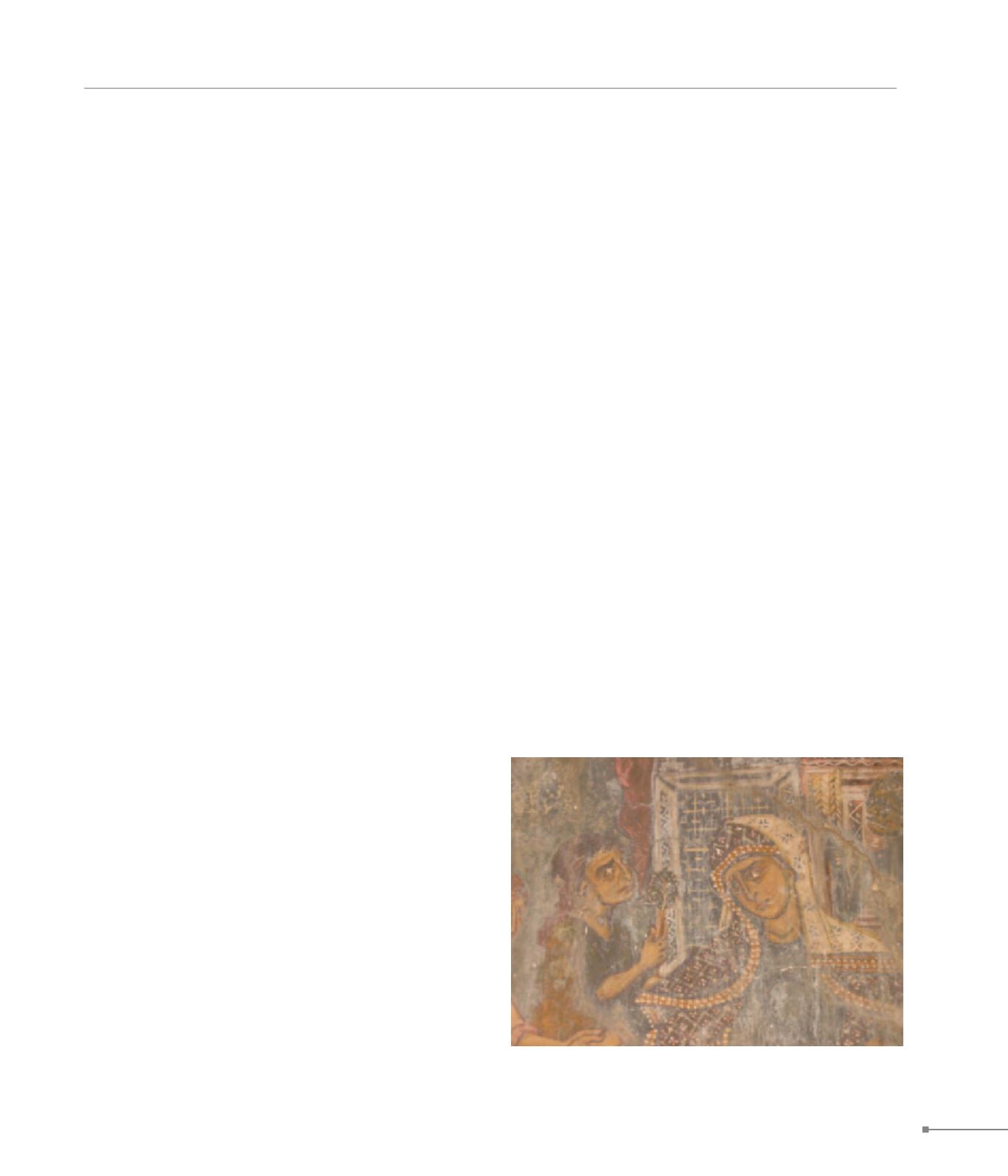
Mikri Episkopi.
Tsoutsouro. Inatos.
CRETE
277
464. Pyrgos, Saint Constantine, wall painting (Πύργος, Άγιος
Κωνσταντίνος, τοιχογραφία)
462.
Mikri Episkopi.
The church of the Metamorphosis of the Soter, today almost
ruined, was the cathedral of the bishopric of Arcadia, known
from the Tactica (Byzantine treatises on ecclesiastical admin-
istration and protocol) until the 10th c. It is a simple tetrastyle
cross-in-square church with dome and narthex. The 10 or so
churches of this type surviving in Crete were either episcopal
churches or catholicons of monasteries. In the S conch are
the remains of an exquisite depiction of the Baptism, which
is of Palaeologan style of the mid-14th c. In the S chapel of
Saint Nicholas are frescoes of the early 15th c. Well-executed
frescoes, of Constantinopolitan tradition, and dated to 1444
according to a dedicatory inscription, are featured in the small,
barrel-vaulted, single-nave naiskos of Panagia.
463.
Monophatsi.
The fortress was built on the Epano Kasteli hill, near the vil-
lage of Tsifout Kasteli (Fortress of the Hebrews). This Turk-
ish name is derived from a Jewish community that lived there
during the Venetian occupation. The village is also known by
the name Bonifacio. The fortress has been mentioned from
1212, a fact attesting its establishment before the Venetian
occupation. In 1230 it was besieged by local rebels and in
1363 it was repaired. Since then it has been used as the seat
of the Castellany of Monophatsi. In 1630 it is noted that the
fortress is in a poor condition and it was deserted during the
Turkish occupation. Its main fortifications were in the S sec-
tion, where towers, a robust wall and a bulwark survive. At the
highest point, in the SW of the fortress, are found remnants of
a strong, quadrilateral tower. The barrel-vaulted, single-nave
church incorporates elements from its original construction in
the second Byzantine period. The fortress controls a very wide
area of the fertile Messara Plain and has visual contact with the
fortress of Melissa.
Outside the nearby Ini settlement, where the city of Arkades is
located, the ruins of a three-aisled basilica with transept and
sculpted decoration have been excavated.
464.
Pyrgos.
The church of Saints George and Constantine has kept two
of the three barrel-vaulted aisles. In the original N aisle the
evangelical scenes and the life of Saint George are typical ex-
amples of the folk-style archaic art of the 13th c. In the S aisle,
dedicated to Saint Constantine, there are frescoes from two
periods: in the E section of the barrel vault are scenes from
the life of Constantine dating from 1314-5, according to the
inscription of the dedicator Georgios Pachnoutis. Their style
combines features of the traditional, archaic art of the 13th
c. with the new Palaeologan painting that had been gradu-
ally infiltrating Crete since the early 14th c. The evangelical
depictions in the W section of the barrel vault represent Palae-
ologan art that had completely infiltrated Cretan painting in the
mid-14th c. With this style is associated the second inscrip-
tion, near the W door, mentioning Pachnoutis as the dedica-
tor, but the date has been destroyed. Mention of the same
patron in the two inscriptions reveals the quick acceptance of
artistic developments that took place on the island in the first
half of the 14th c.
465.
Tsoutsouro. Inatos.
In Tsoutsouro was the ancient city of Inatos, seaport of Vienos.
The important Early Christian basilica that has been excavated
there features well-executed sculpted decoration dating from
the 6th c. Besides the interesting architectural elements, Ara-
bic inscriptions have been detected, a fact that makes plausi-
ble the view that the first disembarkation of the Arabs was at
the Charakas site.


